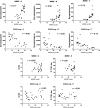Decreased synaptic proteins in neuronal exosomes of frontotemporal dementia and Alzheimer's disease
- PMID: 27601437
- PMCID: PMC5102122
- DOI: 10.1096/fj.201600816R
Decreased synaptic proteins in neuronal exosomes of frontotemporal dementia and Alzheimer's disease
Abstract
Synaptic dysfunction occurs early in senile dementias, presumably as a result of decreased levels of functional synaptic proteins as found in autopsied brains of patients with Alzheimer's disease (AD) or frontotemporal dementia (FTD). Plasma neuronal-derived exosomes (NDEs) were recovered by precipitation and immunoabsorption from 12 patients with AD, 16 with FTD, and 28 controls in a cross-sectional study, and from 9 patients with AD, 10 with FTD, and 19 controls in a longitudinal study. Six synaptic proteins in NDE extracts were quantified by ELISAs and normalized for exosome amounts. NDE levels of synaptophysin, synaptopodin, synaptotagmin-2, and neurogranin were significantly lower in patients with FTD and AD than in controls, but those of growth-associated protein 43 and synapsin 1 were reduced only in patients with AD. Functionally relevant phosphorylation of synapsin 1 serine 9 was reduced in patients with FTD and AD, although total synapsin 1 protein was higher in FTD than in controls. NDE levels of synaptotagmin, synaptophysin, and neurogranin were decreased years before dementia in patients with FTD and AD. NDE levels of synaptopodin, synaptotagmin, and synaptophysin, but not of amyloid β-peptide 42 or P-T181-tau, were correlated significantly with cognition assessed by mini-mental state examination or AD assessment scale-cognitive subscale. NDE synaptic proteins may be useful preclinical indices and progression measures in senile dementias.-Goetzl, E. J., Kapogiannis, D., Schwartz, J. B., Lobach, I. V., Goetzl, L., Abner, E. L., Jicha, G. A., Karydas, A. M., Boxer, A., Miller, B. L. Decreased synaptic proteins in neuronal exosomes of frontotemporal dementia and Alzheimer's disease.
Keywords: biomarkers; cognition; neurotransmission; proteinopathy.
© FASEB.
Figures



References
-
- Kalia M. (2008) Brain development: anatomy, connectivity, adaptive plasticity, and toxicity. Metabolism 57, S2–S5 - PubMed
-
- Selkoe D. J. (2002) Alzheimer’s disease is a synaptic failure. Science 298, 789–791 - PubMed
-
- DeKosky S. T., Scheff S. W. (1990) Synapse loss in frontal cortex biopsies in Alzheimer’s disease: correlation with cognitive severity. Ann. Neurol. 27, 457–464 - PubMed
Publication types
MeSH terms
Substances
Grants and funding
LinkOut - more resources
Full Text Sources
Other Literature Sources
Medical

